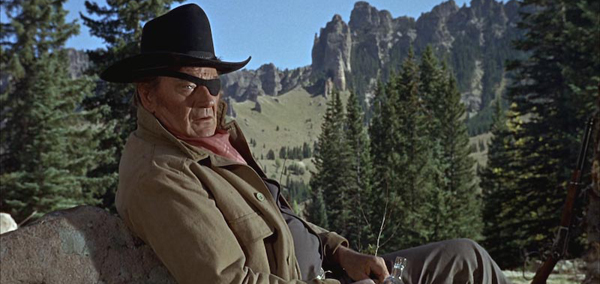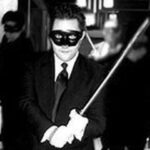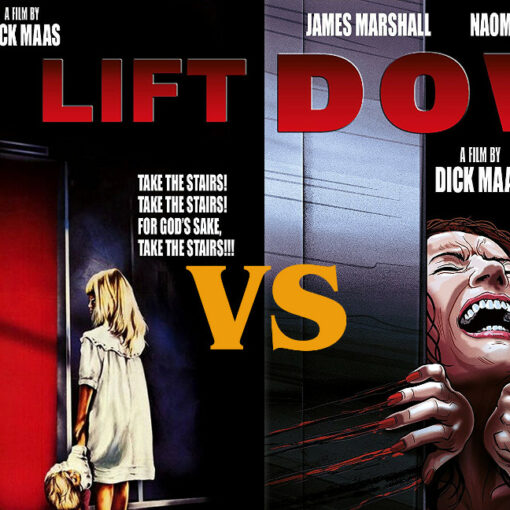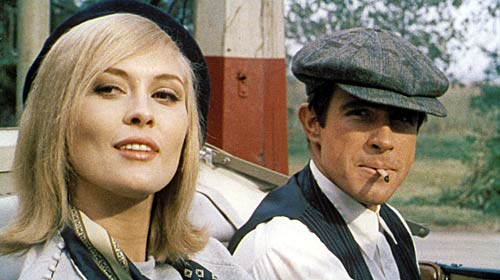I recently watched the remake, or to be more precise the alternate adaptation of the book True Grit is based on directed by The Coen Brothers. I thought the film was well made but at the same time I had my problems with it. Since I’m a longtime fan of the original and also a big fan of The Coens, I thought I’d take an honest, straight forward look at the two films and point out what I did/didn’t like.
U.S. Marshal Ruben “Rooster” Cogburn
John Wayne’s U.S. Marshal Ruben “Rooster” Cogburn was one of his finest roles. The character was a cantankerous ol rebel of the Wild West that was deadly with a pistol, enjoyed playing a post-meal game of cards with his friend, the shopkeeper Chin Lee and drinking his whiskey. He also owned an orange tabby cat he called General Sterling Price. This is a small detail but it showed that Rooster wasn’t just about bounty hunting and boozing. Wayne had been in so many Westerns from the 1930s on and True Grit was one of his last and best performances. He had developed his western persona so much by this time he didn’t even have to act. He was basically playing himself which just made the film easier to get into and enjoy. One of the most important parts of the film was his special relationship with young Mattie who he affectionately called “baby sister” and how it progresses.
Jeff Bridges’ Cogburn is interesting simply because he’s always a master craftsman that brings alot of charisma and ideas to whatever role he’s in. I can’t not mention his now legendary character “The Dude” in The Coens’ cult classic The Big Lebowski. He’s perfect in it. The main problem I had with his characterization in True Grit was his speech. Rooster is such a complete marble mouth his dialogue becomes really tough to understand. This may have been a deliberate choice on his part or one The Coens made to give him that eccentric touch they like to have in their movies but it actually doesn’t help it. Another negative detail is Rooster and Mattie never really connect like they do in the 1969 film. There is no familial bond that we see form between them.
Mattie Ross
The main character Mattie Ross is a vengeful, serious, stubborn young girl who is out to get a criminal on the run named Tom Chaney the killer of her father and numerous other men. Hailee Steinfeld shines in her role as the snappy, no nonsense Mattie. Her take on the character is relatively close to that of Kim Darby who was excellent in the 1969 film. Throughout the film Steinfeld proves to be a formidable actress who can hold her own against all the male actors. It’s a standout performance.
Texas Ranger LeBeouf
Glenn Campbell a popular country singer (you might know his song “Rhinestone Cowboy”) was cast in the role of Texas Ranger LeBeouf in the earlier film and he does a good job although it’s nothing special. Matt Damon’s LeBeouf has a bit more character depth, better dialogue and is one of the most interesting people in the film.
Tom Chaney
Jeff Corey’s Tom Chaney was much more of a deranged scoundrel whereas Josh Brolin who had previously appeared in The Coens’ modern western/crime film No Country For Old Men is really not quite as convincing. His dialogue readings also came off very dull and one note which I didn’t like. Brolin is a good actor but his cameo as Chaney wasn’t a very memorable performance.
Lucky Ned Pepper
These dual performances are the closest for me between both films mainly because Barry Pepper has alot of the same dialogue as Robert Duvall did. One thing I liked alot was Pepper’s look. At first I wasnt even sure if it was him, then I recognized his face. They did a great job turning him into a dirty outlaw with crooked teeth and a weathered face. Like Duvall, his Ned Pepper doesn’t come across as a total villain but someone who lives by his own code and he’s actually one of the more likeable people in the story. Pepper is always a solid actor who makes a project better. From his work in Saving Private Ryan to The 25th Hour to this film.
DIRECTION & SOUND
One thing that is a main difference between the two films is the stylistic visual approaches and how their respective moods and overall technical aspects come across to viewers.
Henry Hathaway who was one of the legendary old school directors in Hollywood went for a more traditional set up with his shots. The earlier film was much brighter and more naturalistic and didn’t rely on alot of tricks or flourishes (which is often used with today’s easy access to technology). This made it easy to understand and had a broad appeal to audiences.
The Coen Brothers are known for their inventive, offbeat direction and cinematography and in True Grit they don’t dissapoint by using a variety of photographic effects and interesting color schemes giving the film a washed out, gothic look. Their aesthetic in this film really has more in common with something like a Tim Burton movie than a classic Hollywood western. It was interesting to look at and I appreciate their darker spin on the tale but at the same time it didn’t fill in any meaningful spaces in the story for me.
The music between both films is another big difference. In 1969, the score by Elmer Bernstein reflected the times and was more upbeat. It featured the main song by Glenn Campbell which was a pop folksy ballad. The Coens’ film score by their collaborator Carter Burwell is of course more somber in tone. It’s actually closer to a thriller than a Western.
THE ENDING (Spoilers)
The original films finale is certainly happier and just more enjoyable to me. The Coens version is downbeat, cold and unsentimental. As opposed to the 1969 film which ends on a positive note, in The Coens’ film Mattie Ross never sees Rooster again after their adventure and years later when she returns to visit him at a Wild West Show she finds he has died. We also learn that Mattie is a frigid old maid who seems to look down on everyone and for me this change actually ruined the entire film because of who I had hoped she would be in the end.
Overall, I found the Coens’ adaptation of True Grit to be close to the original film in the plot but the various changes that were made to be more in line with the story the films are based on didn’t improve on it much at all. While the first film reminds me of a coming of age adventure, bonding and happiness, the remake is very unemotional and negative and I wasn’t touched by the characters in any way.
My personal choice between the two still is the first, lighter version of True Grit. I grew up with it and I’ve really come to enjoy it more and more over the years. There’s a saying that goes: “If it ain’t broke, don’t fix it” and in this case that definitely applies.
What did you think? Let us know in the comment section below!












23 thoughts on “TRUE GRIT: A Comparison”
i can’t watch it,why do they re-make films that are so good to start with?
it was the coens, thats the main reason i watched it. i dont know if i wouldve otherwise
would not call it a remake. they are simply two very different adaptations of one and the same book, with the coen version probably the more true to the book
it may be closer to the original story but its not that different from the first film, its just darker and more negative.
It was the first review I saw (Nov. 7, 2011) that even mentioned
General Sterling Price. My 2G grandfather helped chase Price
out of Missouri in 1861, so I took it personally that the cat was
ignored by the Coens.
def like the original more, the coens are great, but idk why they remade that movie. it was sort of a dud.
I personally prefer the Coens’ version. I feel the exact opposite as you: to me, the colorful, cheerful atmosphere of the original film kind of ruined the revenge and violence in the story. I always thought the movie should be darker, but maybe that had to do with Hollywood at the time Hathaway’s True Grit was made. That’s why I was pleased to see the Coen Brothers finally “corrected” the flaws I saw in the original.
I loved the Duke’s acting, though – to me, his best performance was in The Searchers.
First, thanks for your reply!
I really dont think the overall quality/lasting effect of The Coens’ version matches the Hathaway film either, thats why I did this comparison and made my diff points. I love dark cinema but that aesthetical choice alone couldn’t make me enjoy the remake more. Besides that, I dont consider this to be one of The Coens better works.
Both versions are excellent however all the hype about the Coens version being closer to the book is false.Charles Portis novel is almost exactly like the John Wayne/Henry Hathaway version the only exception being that the 2010 film does stick closer to the Victorian era language of the novel.While the original film does keep many of the unusual words that we almost never hear today they were smart enought to realize that modern audiences would get into a better flow with lines like them hogs instead of those hogs.Also everything original about the new film such as the bizarre bear man and the indian who barters with Rooster for the dead body were made up and werent even in the book.I believe that the Coens were banking on the fact that the younger generation doesnt read books anymore than they have to and that they just dont like films that are older than 10 or 15 years so they can foist a remake and its something totally new to most younger people.They even had the book reissued in a special edition that coincides with the release of the 2010 version but if anybody cares enough to pick it up and read it it is still much closer to the 1969 film.
i just prefer the traditional style of the 1969 film over the coens darker offbeat version. ive seen all their movies so i knew they’d add those weird touches but it just didnt work for me. its a well made film but it doesn’t give me the satisfaction i get from the earlier one.
I thought the Wayne version was a bit of fluff and the Coen Brothers version was a more realistic portrayal of the times. I have read much about the past and its not fluffy and positive like most people crave it to be. The comment that the Coen brothers are banking on the younger generation and not liking movies older than 10-15 years old. The Coen brothers did not “foist” this movie on anyone. Just made it more realistic and thus MUCH more entertaining. The old hee haw type cowboy experience in the original might have passed as great cinema then but not now. This younger generation and any generation for that matter demands a more realistic story. I love the site
The remake IS closer to the source material but that doesn’t make it a better film or a better Western. Thats what this post was about.
They are both good in their own separate ways. The 1969 is more fun. The 2010 is more real. After growing up loving the 1969, I as ready to see how this story would play if it was ‘nonfiction’. There is very little to knock for either.
John Wayne’s “Best” was in “Red River”. John Ford told Hathaway he didn’t know The Duke could “Act”! Except for Glenn Campbell’s insignificant contribution – the supporting actors in both films are truly outstanding with both Matties in memorable performances. For us raised on Wayne movies from “Stagecoach” to “The Shootist” – we marveled at his “Rooster Cogburn” and no one can fault Jeff Bridges on his “True Grit” in any role Hollywood has handed him! So… declare a tie – because different “strokes” for the folks of “different times”!
I grew up near Ridgway, CO where a big part of the movie was filmed. My dad and I hunted elk where the final battle took place. I worked at a drug store in nearby Telluride and took my dad to see the original True Grit. We used to go to Montrose and see the town of Ridgway being prepared for the movie. They built wooden sidewalks, painted store fronts, etc. We saw the gallows being built and got to watch part of the filming. Having said that, I have a strong emotional tie to the first movie and got to meet John Wayne and Glen Campbell when they came to the drug store. My first thought on the ‘remake’ was – How could they do that? Watching both movies and after reading the book, I think Coen’s version is better. The music is better, and the scenes match the book better. True Grit by the Coens gets my vote for the better job. Both are very watchable.
Ive come to like The Coens version more than I did when I wrote this. I think both are really good.
After seeing both movies i REALLY want to read the novel. Loved both but my fav? The original of course.
I recently read the novel by Charles Portis, mainly to see how faithful the Coen Brothers weer to the book. I watched the original movie when it came out years and years ago. I have great memories of the film in large part because the movie was filmed in the area of Colorado where it was mainly filmed. I honestly would have to see the original movie for a direct comparison, but having just re-watched the new adaptation I have to say that I think the Coen Brothers told the superior tale, and made a good choice to tell the story with Mattie as the main focus as in the book. I did miss General Sterling Price though…
oh, come on, glen Campbell ruined the original. he was beyond bad. the upgrade to matt damon was so astronomical as to be stunning. I also thought duvall was better than the new guy. I thought Duvall’s ned pepper was riveting.
Here’s a piece of trivia. in pulp fiction the hit man says, “I don’t usually say this to someone unless I’m fixing to bust a cap in their ass.” bust a cap means to shoot you. I believe that term gained modern usage through the original true grit. ned pepper says to the girl, “I’ve never busted a cap on anybody much under the age of fifteen–”
bust a cap, of course, refers to the early days of firearms when you loaded the cap and ball separately. So, when you fired the weapon, you busted the cap. I find it interesting that the movies brought such an antiquated term back into general parlance. Of course the movie true grit, and especially the book, had many such period terms that have gone out of use. I think the revival of the term had as much to do with the charisma of Robert Duvall’s portrayal of ned pepper as the term itself.
Or maybe this is just my imagination.
This is amazing, thank you for revealing the source for this phrase.. I’ve heard it most of my life and always thought it originated from hip-hop lyrics or Boys in the Hood. This is interesting.
Glen Campbell once said, “he never acted in a film before TG and after it that still applied.” But Matt Damon looked like a high school senior trying to spit out Shakespeare in this and I’m a big fan of Matt’s. There was something natural and authentic with Glen. Duval, Hopper, and even the kid who spoke in animal noises were far better in the original.
I agree it is one of Wayne’s finest performances, the Oscar was more than just a body of work overdue win there. Stienfeld vs Darby is tougher, you got to give Haley props for the dialogue but Kim had real moxie that Haley did not.
Overall why did they not leave well enough alone. Finally Bridges just was cartoonish.
I prefer the Coen Brothers version because it sticks with the original Charles Portis dialogue, which has a sort of tongue-in-cheek poetry about it. My theory is that the Coen brothers have always been influened by Portis, and finally got a chance to make a film from his work. The rhythm and the humor of the dialogue reminds me of Charles Portis in every Coen Brothers film, not just TRUE GRIT.
I was looking for a good western to watch tonight. I knew there was a second True Grit and watched it decades ago. The latest True Grit was “not” a let down. It was an excellent Movie I might watch again tonight, although I have seen it (both versions) so many times, there will be no surprises. It was the True Grit (1969) as Mattie Ross character which caught my eye on YouTube trailers. I thought it was the the same actress which did bring me back to google, ending up here. Mattie in my mind being the lead character, and the Movie revolved around her not John Wayne and not Glenn Campbell/Matt Damon. Now I have revived my memory, i guess I will watch another Western tonight.